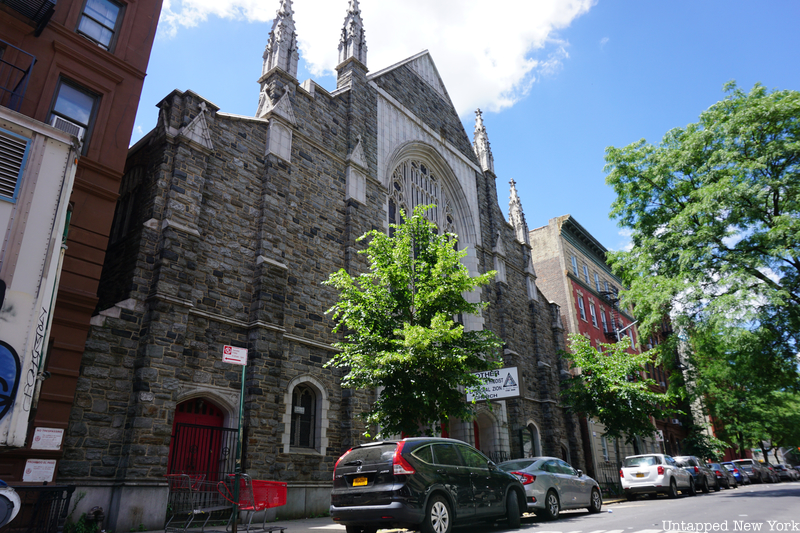6. Former Mother AME Zion Church: 158 Church Street, Financial District

The Mother African Methodist Episcopal Church was the first Black church in New York State, founded in 1796. The church, known at the time as the Freedom Church, became a stop along the New York Underground Railroad. The church distanced itself from the Methodist Episcopal Church, which at the time practiced segregation. The church was also a focal point of Black social activism, attended by Frederick Douglass, Harriet Tubman, and Sojourner Truth. Truth was a member of the church and would give talks to the congregation about the abolitionist cause. Because of the church’s association with abolitionism, it was subject to a three-day anti-Black riot in 1834. At the church, 1,500 people gathered in 1850 to protest and raise nearly a thousand dollars to overturn the capture of James Hamlet, who was sent back to Maryland after gaining his freedom.
The church relocated to Harlem in 1925 to its present-day location at 140-7 W. 137th Street. Though nearly a century later, the church continued to pull in high-profile and influential Black figures, including Paul Robeson. He spoke from the pulpit about civil rights causes, during which time he worked with leading Harlem Renaissance figures including Langston Hughes. Bertha Des Verney, a musician and playwright, hosted community outreach events and fundraisers as the church’s choir and drama director.
7. Downing’s Oyster House: 5 Broad Street, Financial District
Downing’s Oyster House was one of New York’s most famous oyster houses of the 19th century. Nicknamed the “New York Oyster King,” Thomas Downing was one of the wealthiest New Yorkers at the time of his death and used his influence to spread awareness of abolitionist causes. Downing, born to freed slaves, moved to New York and began selling his oysters on the street. He would cater to the elite of New York and secure the highest-quality oysters from captains before their auction. He eventually opened Thomas Downing Oyster House in 1825, adorned with chandeliers and expensive silverware and linens. The restaurant was located on the outskirts of Five Points, a predominantly African American neighborhood, and featured significantly more lavish fare than any of its competitors.
As Downing expanded his restaurant operations, he leveraged his growing fame for abolitionist purposes. Between 1825 and 1860, Downing and his son helped fugitive slaves reach Canada by sheltering them in the restaurant’s basement. Few diners knew of these secret operations, which kept fugitives safe from bounty hunters. He also founded the United Anti-Slavery Society of the City of New York and advocated for equal Black male suffrage.
8. Colored Sailors’ Home: 330 Pearl Street, Financial District
Located on 330 Pearl Street, the Colored Sailors’ Home was a lesser-known New York Underground Railroad site with a fascinating history. The Colored Sailor’s Home was opened by abolitionist William Powell and it served as a boarding house for sailors of color. The sailors were provided with food and safe housing, and they received professional guidance as well as various other employment opportunities. In a series of letters, Powell outlined the struggles of many Black sailors arriving in New York with no place to stay, which he notes goes against the idea that the North is freer than the South.
In addition to sheltering Black sailors, the home was also an important stop on the Underground Railroad. Anti-slavery activists would meet at the home, and Powell disguised fugitive slaves and gave them food and shelter. William Powell would eventually move to Europe and the home was transferred to Albro and Mary Lyons, who continued Powell’s legacy. The Lyons lived in the home from about 1851 to 1862, continuing to shelter Black sailors and fugitive slaves. It was estimated that Powell and the Lyons family assisted over 1,000 fugitive slaves en route to the North.
9. Shiloh Presbyterian Church: Frankfort Street/William Street, Financial District
Shiloh Presbyterian Church in the Financial District was founded alongside a handful of others that catered to the African American population of Lower Manhattan. The church was first founded on Rose Street in 1822 as the First Colored Presbyterian Church. Its founder was Samuel Cornish, the man who founded the nation’s first Black newspaper Freedom’s Journal. After moving to Frankfurt Street, the church was led by Theodore Wright, whose home was located at 2 White Street. During the mid-1800s, the church also served as a stop on the New York Underground Railroad, aiding dozens on their journey north.
During the Civil War, the church was led by Henry Highland Garnet, who attended the African Free School and gave the 1843 “Address to the Slaves,” urging them to rebel against their masters. Garnet led the church in boycotting industries that were products of slave labor and held a memorial for John Brown after his hanging in 1859. The church also assisted the Black population during the 1863 Draft Riots. Garnet was also the first African American to address the U.S. House of Representatives, doing so in February 1865 urging them to abolish slavery. A descendant church of Shiloh Presbyterian is now in Harlem.





